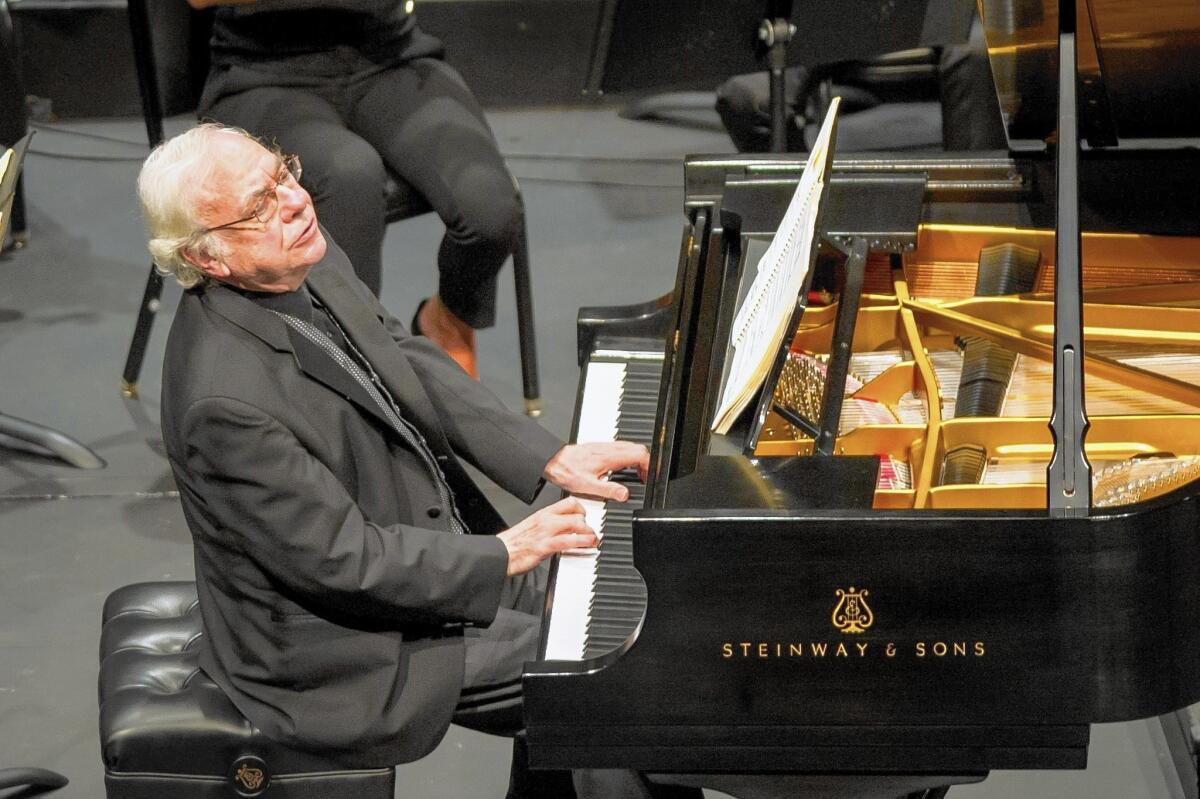Review: Los Angeles Chamber Orchestra explores Mozart by way of Sacred Harp, Haydn by way of flamenco

- Share via
The ways in which old and new music interact are a difficult subject in classical music. Is it the present’s role to tell us something about the past, or should today’s composers seek in the standard repertory a basis for progress? For some there is little connection: then was then, and now is now.
The Los Angeles Chamber Orchestra tried out various strategies at its concert Sunday night in Royce Hall, UCLA. In the first half of the program, a piece written last year by an emerging New York composer preceded Mozart’s Piano Concerto No. 18. Here there were subtly tenuous connections.
For the second half, a recent percussion concerto by an established French composer set the stage for Haydn’s Symphony No. 88. This time there were no meaningful links.
SIGN UP for the free Essential Arts & Culture newsletter >>
Timo Andres’ short chamber symphony “Word of Mouth” opened the concert. Andres is an unusual figure on the Brooklyn scene. His style of dress is neither hipster nor disinterested but preppy. He is an accomplished pianist who made a splash five years ago with an inventive “recomposition” of Mozart’s Piano Concerto No. 26. It was a highlight of the 2014 Ojai festival, as was an Andres’ solo Schumann recital.
“Word of Mouth” looks back as well, this time to Sacred Harp singing, an ecstatic 19th century a cappella group vocal tradition in the American South. A group called the Word of Mouth Chorus helped keep the tradition alive in the 1970s with a recording on Nonesuch that had considerable influence on the folk music scene (Andres also happens to be a Nonesuch artist).
Andres doesn’t so much translate vocal music into an instrumental style as slightly decompose “Weeping Mary,” a song on the Word of Mouth album, focusing on a few notes and especially the way they correspond not to standard tuning but to eerie microtonal overtone singing.
Andres begins with skewed fanfares, many happening irregularly at once, as in the music of Charles Ives. Sacred Harp singing allowed for flexibility in pitch, and in the nexttwo movements tones bend in the horns, as bits of “Weeping Mary” are magnified into arresting tears of rapture.
The final two movements, slighter fanfares and peaceful closing, are nervous-seeming returns to normalcy, as if the past were keeping check. But as in Andres’ fanciful play on Mozart, the further he strays from tradition the more remarkable a composer he becomes.
A kinship with Mozart wasn’t the only thing tying a new piece into the Concerto in B-flat, K. 456. “Word of Mouth” was commissioned by Orpheus, the New York chamber orchestra, and Sunday’s soloist, Richard Goode, once made a incandescent recording of the concerto with Orpheus (again on Nonesuch). Indeed, Andres has written that watching how a fellow Brooklyn composer worked with Orpheus, which performs without a conductor, was the impetus for “Word of Mouth.”
That Brooklyn friend, Gabriel Kahane, happens to be the son of LACO’s music director, Jeffrey Kahane, who led one superb performance after another Sunday and was the mastermind behind the program. Kahane Sr. has also appeared as a pianist in Mozart with Orpheus.
Programming algebra, however, is not necessarily linear, and none of these things added up to an illuminating performance of one of Mozart’s lesser-played concertos, a piece for connoisseurs who marvel at its craftily hidden delights. Kahane’s approach was emphatic. Goode’s was not, although he played with considered elegance. Each musician gave every indication of being respectful of the other, but compromise isn’t always a solution in performance.
The biggest applause of the night came for another concerto, Emmanuel Séjourné’s Concerto for Marimba and Strings, which featured LACO principal percussionist Wade Culbreath as soloist. There were ear-piercing whistles and screams for Culbreath’s virtuosity and jazzy flair with tricky rhythms from the kind of enthusiastic young people classical ensembles are eager to court. So Séjourné’s concerto couldn’t be called all bad.
Except that it is. A percussionist and pedagogue in Strassbourg, he begins his concerto, which was written 2006, with a string theme cinematically soupy enough that it might underscore the opening credits of a forgettable French tear-jearker. The marimba theatrically takes a harsher stance, but soup drowns all as this tacky drama plays out. The second movement is conventionally flamenco-based, even with a fancy meter of 11/8.
If Séjourné went in for flamenco, Haydn in his Symphony No. 88 hints at bagpipe music in his third movement for a touch of folk style. Any minimal relationship between the two composers ends there. Haydn turns contrasts not into soap opera but magical music tricks. His cards are never laid out on the table, and Kahane dazzlingly animated details and kept a listener guessing.
For the last measures he stepped off the podium, stopped conducting and let the orchestra create delight on its own in what seemed a final tribute to the conductorless Orpheus.
ALSO:
An expressive slowness to Jacaranda, Sankai Juku performances
Dudamel and the L.A. Philharmonic deliver a riotous ‘Spring’
Pianist Andras Schiff mesmerizes with last sonatas of 4 composers
More to Read
The biggest entertainment stories
Get our big stories about Hollywood, film, television, music, arts, culture and more right in your inbox as soon as they publish.
You may occasionally receive promotional content from the Los Angeles Times.











